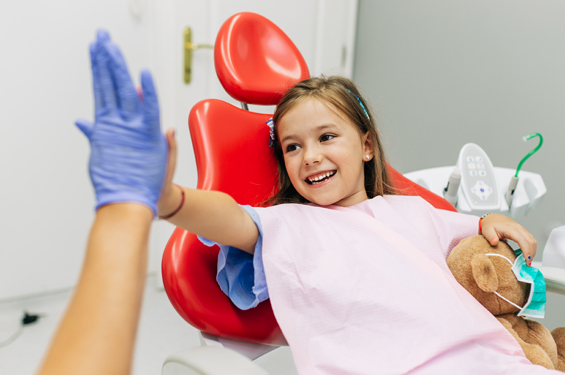
Gentle Sedation Dentistry for Kids
One of the most commonly used types of sedation is nitrous oxide, which is also known as laughing gas. This helps many children relax during their procedure.
Nitrous oxide is a combination of two different gases–-oxygen and nitrous oxide. We administer the gas through a small mask placed over your child’s nose. The gas will make your child relax without the full effect of anesthesia.
Did you know:
There are three different types of sedation dentistry available for patients to choose from:
- Inhalation Sedation, also known as laughing gas or N2O, provides a euphoric feeling to make dental treatments more pleasant.
- IV Sedation/General Anesthesia, with the presence of an Anesthesiologist, allows for completion of all dental treatment without patients having any recollection of the experience. The Anesthesiologist focuses on administering the proper dosage of medication to keep the patient comfortable and sedated, allowing the dentist to complete all treatments safely and efficiently for the best outcome.
Frequently Asked Questions
Should I choose sedation dentistry?
Consult with your dentist to determine if sedation is the right option for you. Before considering sedation dentistry for your child, their medical history will be reviewed and medical clearance from their Pediatrician will be required. It is important to discuss with your dentist whether N2O or General Anesthesia is the best choice for your child's needs, as sedation treatments vary. Your eligibility for sedation will be based on factors such as age, health, and any medications you are currently taking.
What should I expect on the day of treatment under General Anesthesia?
Upon arrival at our facility, we will measure your child's weight and assess their health, including their recent food and drink intake. The Anesthesiologist will meet with you and your child, conducting examinations of their airway and heart to confirm they are suitable for General Anesthesia. A parent can accompany the child to the treatment room to receive the sedation mask. The parent will then be escorted to the waiting room while the dental procedures, typically lasting 1-2 hours based on individual needs, are performed.
Are there any precautions I need to take after being sedated?
If patients received only N2O for treatment, they may resume normal activity. However, if the treatment was performed under General Anesthesia, we recommend patients refrain from physical activity for the day and relax at home. Most patients can return to normal activity or school the following day.
Benefits Of Preventative Dental Care
At Chatsworth Family Dental Group, we believe in the power of a smile. We prioritize keeping your smile bright and healthy because it's not just about looks, it's about your well-being. Our preventative dental care goes beyond just cleanings. Here's how we help:
- We fight cavities by removing plaque and tartar buildup that can be hard to reach with regular brushing and flossing.
- We keep gum disease at bay by detecting and treating early signs of gingivitis during regular checkups.
- We ensure fresh breath by eliminating the source of bad breath through regular cleanings and preventative care.